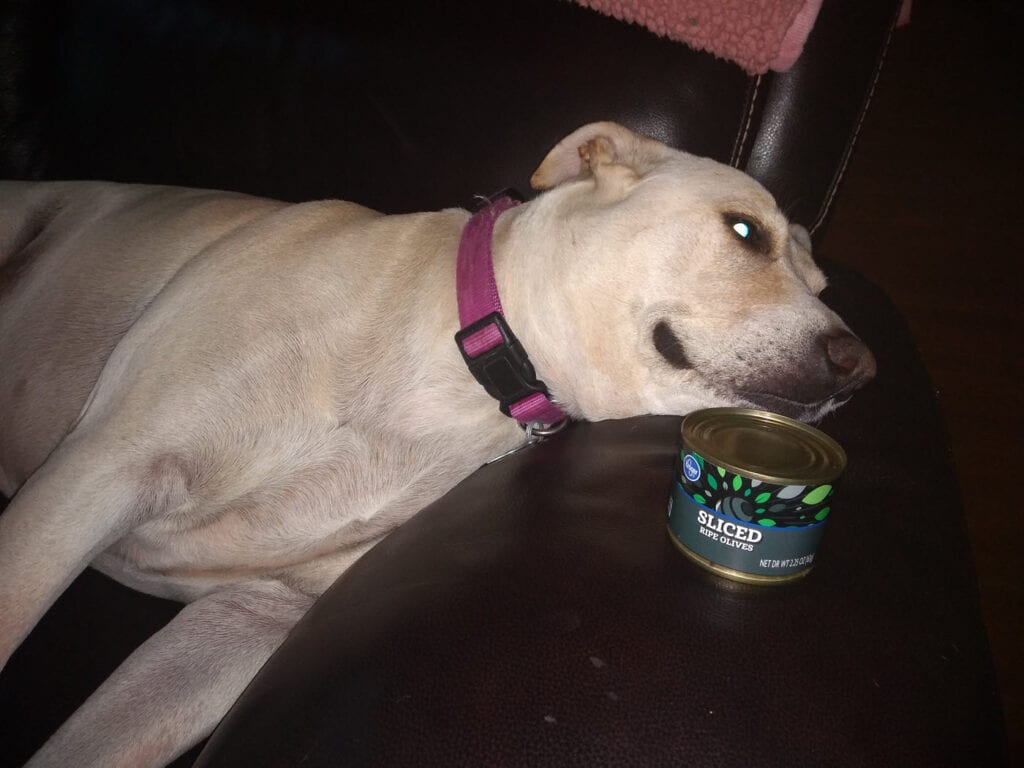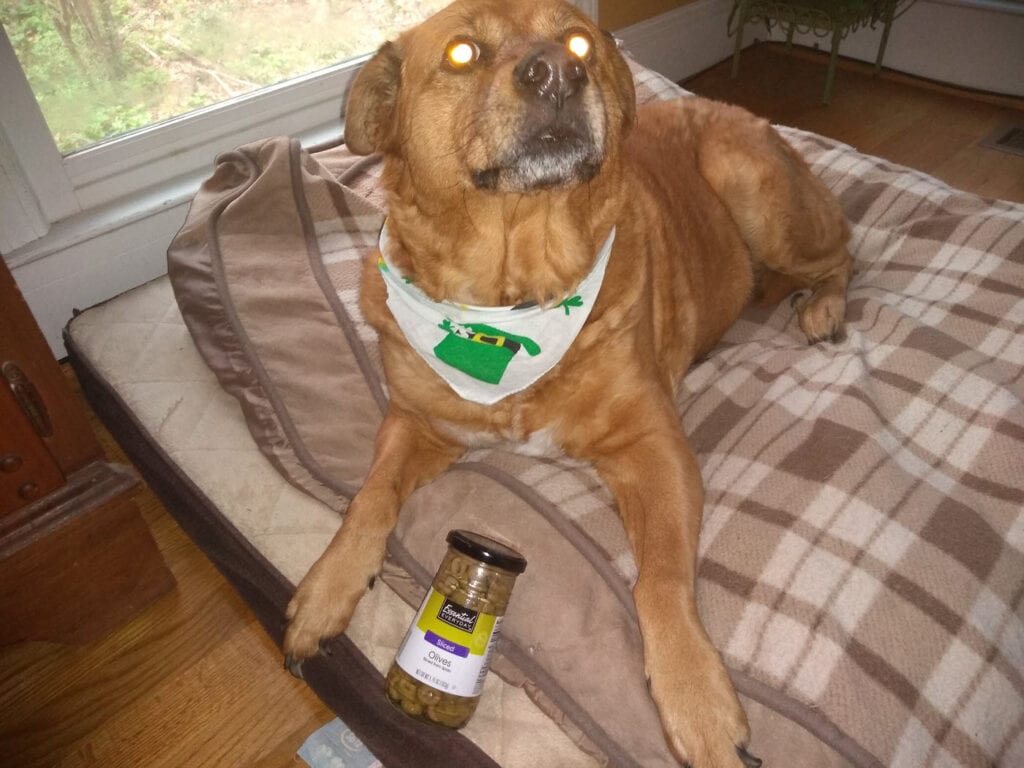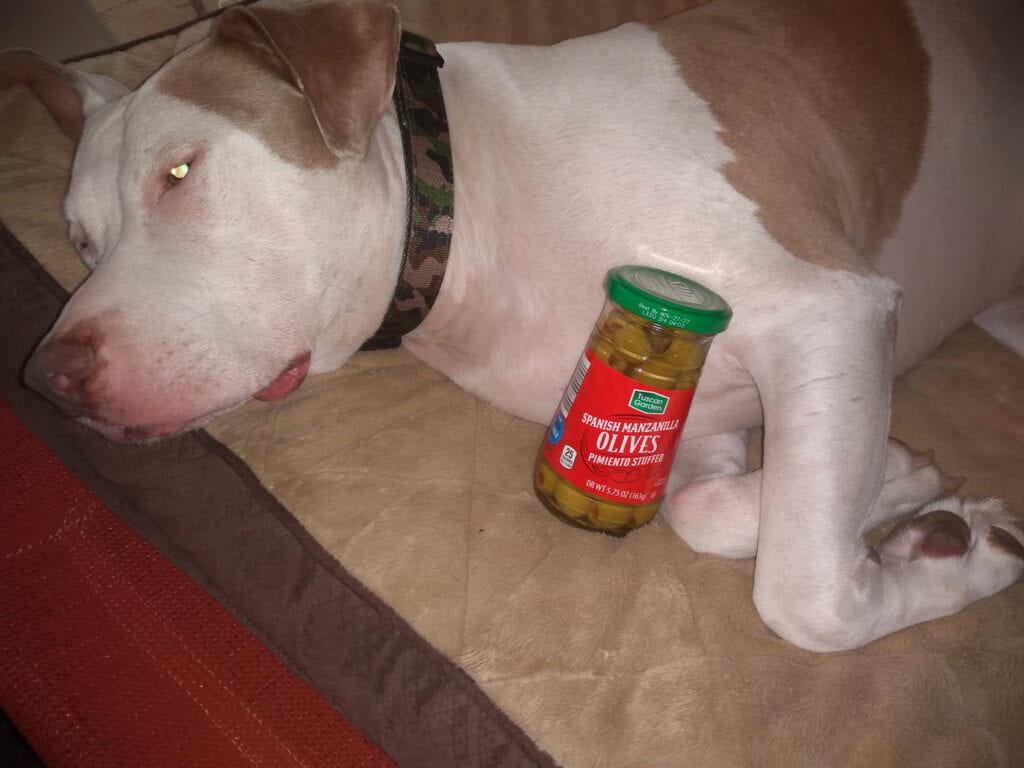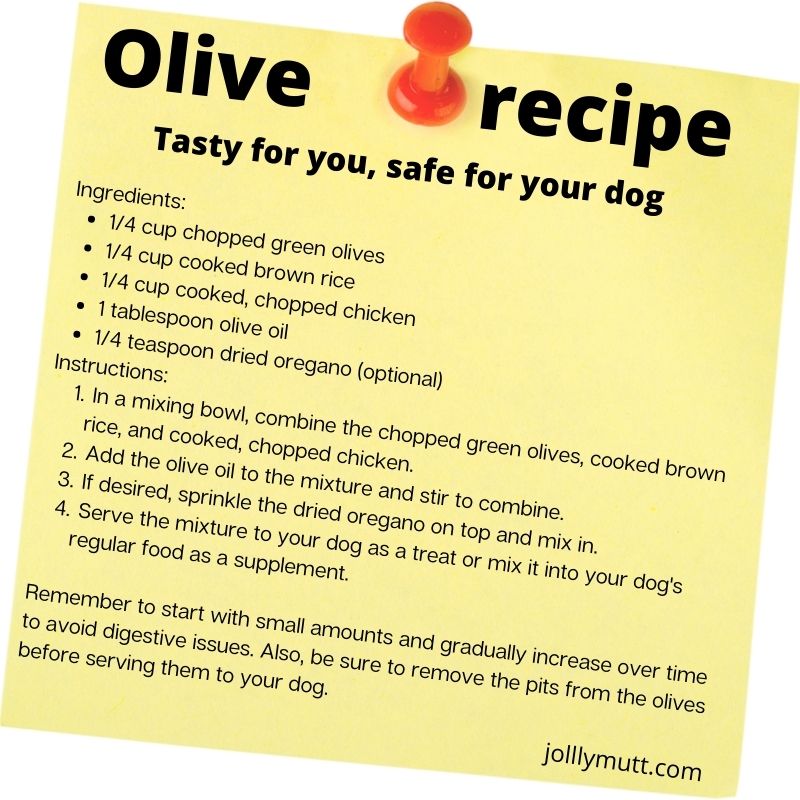Can dogs eat black olives? Or green? Or whatever color? The short answer is “yes”; it’s fine for your dog to eat olives, but there are considerations:
- Olive pits are bad for dogs (they can damage teeth)
- Whatever the olive is soaking in may be bad for dogs
- If the olives are stuffed, that may introduce something that is not recommended for dogs (jalapeno stuffed olives, anybody?)
So there are things to be careful about. We share more info below.
While olives are undoubtedly healthy for people, what about dogs? Whether you’re looking to add variety to your dog’s meals or want to learn more about the nutritional value of black olives, this article will provide valuable insights into this popular food and its impact on your furry friend’s health.
Key Takeaways
- Moderation is Key: While olives are generally not toxic to dogs, they should be given in moderation. Olives are high in salt and can lead to digestive upset or sodium-related health issues if consumed excessively.
- Pit Removal is Crucial: Always remove the pits from olives before giving them to your dog. Olive pits can be a choking hazard and may damage your dog’s teeth or digestive system.
- Monitor for Allergic Reactions: Some dogs may be allergic to olives or may have sensitivities to certain compounds in olives. Monitor your dog for any signs of allergies or digestive problems when introducing olives into their diet. If you notice any adverse reactions, consult your veterinarian.
Most likely, your dog is fine
If your main concern is “My dog just ate an olive, and I’m concerned”, or “My dog just licked a bowl with olive oil in it”, the short and quick response you’re looking for is that your dog will most likely be fine.

Barring something odd, such as Fido eating a whole bowl of non-pitted, jalapeno-stuffed pickled olives, he’s probably fine.
Watch him for unusual behavior.
Call your vet, of course, since you are a responsible dog owner. But if it was a single olive, or perhaps one or two, there’s no reason your dog wouldn’t be fine.
A major consideration here isn’t so much “Did he eat an olive, or five” but “Did he eat an olive pit, or five″?
The olive pits are seeds normally passed through the digestive tract without harm. Too many can result in blockage and is a case for extreme care (and an immediate call to your vet).
Also, olive pits are hard and can chip your dog’s teeth, which will cause pain and need to be treated. If your dog chews up the pits rather than swallowing them, they can release toxins into your dog’s system.
Call your vet if there is any chance of your dog eating a lot of pits.
That’s the short and sweet answer. For more information, please read below.
What is an olive?
Let’s look at “the olive” to see what it actually is.
First, the olive is a fruit, not a veggie, and has a seed called the pit.
Think of cherries or apricots: Same concept.
They grow on trees and have pits. And each is a fruit.
A primary difference is that cherries and apricots are sweet, whereas fresh olives are painfully bitter when freshly picked.
Olives aren’t ready for consumption until after processing.
The difference between black, green, and purple olives (any color) is when they are picked.
Green olives are picked early in the season, so they are less ripe, while black olives are picked later in the season.
All are picked from the same trees.
There’s no such thing as a green or black olive tree. Just…olive trees. Now you’re ready for Trivia night!
What about Kalamata olives? Same concept, not any different, except they are brown and known for the city in which they are grown: Kalamata, Greece.
Now that we know what an olive is, let’s look at several aspects.
- Are they good for dogs?
- Are they bad for them?
- Should you feed your dog black olives?

Are black olives good for dogs?
Yes, absolutely, but with caveats.
Primary among them is how many your dog eats. If one or two, only good will come of it. A couple at a time is good for your dog’s health.
If more than that, your dog may experience tummy problems and have diarrhea, which we don’t want.
So in moderation, they are fine.
Just don’t start your dog on a full Mediterranean diet; you should be fine.
Some dogs will tolerate them better than others. Some may get sick after eating only a single one, so best to start small and test it out.
Olives are naturally high in vitamins K, E, and A, which are just as good for dogs as they are for us, so again, in moderation, olives are good for your dogs.
Are black olives bad for dogs?
No, not if they are the right black olives.
However, feeding your dog processed olives that are perhaps stuffed with a filling such as cheese, garlic, or jalapeno isn’t recommended.
Pickled or canned olives are usually high in sodium and are not recommended.
Remember that an amount of sodium that doesn’t bother you at all may have a much more intense effect on your dog.
Excessive sodium will dehydrate your dog, which can be dangerous.
Should I feed my dog black olives?
Although they are packed with nutrients, are a good source of healthy fat, are high in vitamin E, and in moderation, will cause no harm, there’s really no reason to feed them to dogs.
You can find many dog snacks and dog food that serve just fine, and save those tasty olives for yourself.
If you do want to share one or two, no problem.
A small number of olives now and then can be a healthy snack for your pooch.
Too many may cause your dog’s stomach to become upset, so proceed with caution. Nobody likes an upset stomach.
Also, keep in mind that at the end of the day, olives are a high-fat food, which is not good for dogs and can adversely affect your dog’s pancreas. So don’t overdo it.
Ensure there is no pit, and rinse the olive to remove brine or salt.
Ideally, you want to share plain olives with your furry friend rather than a stuffed olive.
Then, enjoy an olive or two with your four-legged friend!
My dog just ate a slice of pizza with flavored olives on it – what do I do?
I feel like this is the more likely underlying question.
Your dog accidentally ate some olives, and you want to know what to do.
Snatching pizza leftovers with olives probably won’t introduce any olive-related problems, but what else is on the pizza?
If it was olive bread, what else may have been in it or on it?
If it was a bowl of olives that you had sitting out, were they pitted? Were they processed and so potentially high in sodium and other additives?
How is your dog behaving right now? Is he drooling? Is he acting funny?
All things being equal, your dog is probably going to be fine.
There’s nothing inherently wrong with a dog eating a nice fresh olive.
It’s all those other considerations (how many, processed or not, high in sodium, pits, were the olives stuffed with something, etc.).

Adding olives to your dog’s diet
Always check with your veterinarian, of course.
Assuming your veterinarian approves the addition of olives to your dog’s diet, here’s a simple recipe you could use:
Ingredients:
- 1/4 cup chopped green olives
- 1/4 cup cooked brown rice*
- 1/4 cup cooked, chopped chicken
- 1 tablespoon olive oil
- 1/4 teaspoon dried oregano (optional)
Instructions:
- In a mixing bowl, combine the chopped green olives, cooked brown rice, and cooked, chopped chicken.
- Add the olive oil to the mixture and stir to combine.
- If desired, sprinkle the dried oregano on top and mix in.
- Serve the mixture to your dog as a treat or mix it into your dog’s regular food as a supplement.
*Substitute mashed sweet potatoes for the rice for some variety
For more variety, look at our article for a tasty black olive and prawn recipe for your pooch.
Remember to start with small amounts and gradually increase over time to avoid digestive issues. Also, be sure to remove the pits from the olives before serving them to your dog.
Here’s a tasty olive recipe for your dog – feel free to hang it on your fridge.
JollyMutt

Can dogs eat other vegetables?
Certainly!
As with black olives, this should be done sparingly and should not constitute the bulk of any of your dog’s meals, but veggies such as bell peppers, tomatoes, edamame, or jicama are great snacks for your pup. Again, in moderation.
We have created a comprehensive list of foods your dog should and should eat: Can dogs eat…? 75+ food items reviewed
FAQ – can dogs eat black olives
Is it safe for dogs to eat olives?
It’s generally safe for dogs to have an occasional olive as a treat. However, olives are high in salt, so moderation is key to preventing digestive issues. Always remove the pits before giving them to your furry friend.
Can dogs eat green or black olives?
Yes, dogs can eat both green and black olives, but they should be given sparingly. The high salt content means they should only be an occasional treat.
Are green olives toxic to dogs?
Green olives themselves are not toxic to dogs, but the high salt content can be harmful. Limit their intake to prevent salt-related health problems.
Are dogs allowed black olives?
Yes, dogs can have black olives in moderation. Just remember to remove the pits and be cautious due to the salt content.
Can dogs eat olive seeds/pits?
No, dogs should not eat olive seeds/pits. Olive pits can be a choking hazard and may harm your dog’s digestive system.
Can dogs eat olives raw?
Yes, dogs can eat raw olives, but removing the pits first is important. Raw olives may be harder to digest than cooked ones.
Can dogs eat olives black?
Yes, dogs can eat black olives, but in moderation. Remove the pits and ensure they are not seasoned with any harmful ingredients.
Can dogs eat olives from the tree?
Letting your dog eat olives directly from the tree is not advisable. Olives on the tree may contain compounds that are not safe for dogs.
Can dogs eat olive oil?
Pure olive oil in small amounts is generally safe for dogs and can even offer some health benefits. However, excessive consumption can lead to digestive upset, so use it sparingly.
Can dogs eat olives and garlic?
No, dogs should not consume olives with garlic. Garlic can be toxic to dogs and should be avoided entirely.
Can dogs eat olives with pimentos?
Olives with pimentos should be avoided. Pimentos are often spicy, and some dogs may be sensitive to spicy foods. Additionally, the extra ingredients may not be suitable for dogs.
Can dogs eat green olives?
Yes, dogs can eat green olives occasionally, but make sure to remove the pits and provide them in moderation due to the salt content.
Can dogs eat black olives – final thoughts
Black olives are fine for your dog to eat as long as you consider what else your dog is eating at the same time.
Pits, brine, salt, stuffing, etc., are bad for your dog. An olive or two with any of that is ok, but we still don’t recommend too many.
Lastly, as I re-read this article, I realized I focused entirely on black olives. There is no real difference between a dog eating black olives and green olives.
The results, concerns, and considerations are the same for either.
We often hear, “Can dogs eat [fill in the blank],” so we are working on a series of articles to discuss various types of food. Please see our additional articles on the main dog health page.
Also, for a more informative overview about what your dog should and should not eat, look at our “Can dogs eat…” article, where we cover over 80 food items.
- American Kennel Club (AKC): Bowel Obstruction in Dogs: Symptoms, Treatment, and Prevention
- Banfield Veterinary: Quality diet and nutrition for pets
- Healthline: Olives 101: Nutrition Facts and Health Benefits
- PetMD: Excess Sodium in the Blood in Dogs
- First published March, 2021
- Updated March, 2023
- Updated Sept, 2023
